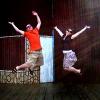Inter-School Collaboration for Conservation Quantification
The Leo Baeck Day School
Robbins Hebrew Academy
Zerofootprint
The purpose of the Inter-School Conservation Quantification Collaboration effort is to empower Grade 8 students and teachers to understand the direct impact that their actions to reduce energy consumption will have. This would inspire further exploration in high school and post-secondary school.
Innovative Aspect
Unlike the current Toronto and Ontario Eco-Schools program, (http://www.ontarioecoschools.org) which groups schools using qualified measurements into bronze, silver, gold and platinum rankings, we plan to establish quantitative measurements and ways to properly normalize them, so we can compare schools and see the quantitative impacts that various energy conservation efforts have.
We want those measurable energy consumption reduction actions to be developed by the Grade 8 students themselves once they understand the overall reality of climate change, what the causes are, and have an understanding of the baseline consumption measurements of their own school, in the context of the community they live in.
Efforts to develop quantitative measurements will be done on a collaborative between participating schools in the 416. Instead of travelling between schools, we would use current social media and web technology to enable collaboration within a school and between schools and between experts both local and remote. We will then expand the collaborative effort to include schools in the 905 region. From there, we would take the effort international and partner with schools outside Canada.
We would also like to work with existing groups such as the Learning for a Sustainable Future and the Kortright Centre of the Toronto Regional Conservation Authority to identify best practices to establish energy consumption baselines and energy consumption reduction exercises which can quantified, and used between schools in the 416, 416 & 905 and 416 & schools in other countries.
How it will help Toronto
Success will help the current eco-schools effort evolve, and establish a collaborative approach to identifying measurable solutions for energy consumption reduction. This effort would have local, national and international implications as we bring the experience of crowdsourcing solutions to energy consumption reduction to a younger demographic
Steps to be taken
Understanding the Current Problem
We will leverage volunteers from the Climate Reality Project to help establish the overall context of what is driving the need to reduce energy consumption.
Establishing the External Baseline
Country --> Province --> City --> School
The external base line is the measurement of actual consumption of energy resources, electricity, natural gas and water. This will be done for each participating school.
We will be able to show the students the starting point at various levels, using CO2 equivalent emission numbers.
At the national and provincial level, we will use the national and provincial inventory numbers documented by Environment Canada in May 2011.
At the GTA Level we will use The Living City Report Card 2011 – An assessment of the environmental health of the Greater Toronto Area, published in March 2011 by Greening Greater Toronto, an initiative of CivicAction.
http://www.thelivingcity.org/lcrc4/
Quantifiable Consumption Reduction Exercises
We will look at the current thoughts of the Inconvenient Youth to identify potential projects which would resonate with Grade 8 level students
http://www.inconvenientyouth.org/
We intend to work with the Learning for a Sustainable Future team to leverage quantifiable energy consumption reduction exercises which they have already documented from around the world. We hope to establish a set of actions which can be done within schools, between schools in the same city / region, and between schools in different countries (Pams of LSF has indicated a willingness to connect to this effort - October 3 comment)
We intend to work with the Kortright Center of the Toronto Regional Conservation Authority, to identify specific experiences they have in quantifying energy consumption reduction exercises, and to leverage other experiences from other resources in their international network (Darryl Gray of Kortright has indicated a willingness to connect to this effort - October 4 comment)
The emission reduction potential will be dependent on the exercises we choose to use and measured against the baseline we establish
Impact to be measured against current baseline consumption (Initial set of ideas)
- Lighting within the school
- Reduction of controllable plugloads
- Setback levels for heating and cooling (occupied vs unoccupied)
- Energy generation
Impact to be measured once external baseline established (Initial set of ideas)
- Creative approaches to carpooling (Reducing distance, number of cars, public transit etc)
- Community Sustainable Agriculture (For consumption in school or for foodbanks)
We are looking to the ClimateSpark SVC community to identify additional energy conservation exercises whose impact can be quantified, to add to the list above.
The Leo Baeck Day School / Robbins Hebrew Academy – providing access to Grade 8 students and Staff, as well as committed parents and alumni
Zerofootprint – providing access to visualization software which will allow normalized comparisons of energy consumption data
Climate Reality Project - Canada – Canadian volunteers, some in the GTA, ready to present in person and through video, the basics of climate change at a Grade 8 level
- http://bit.ly/climatereality-billnye
- http://bit.ly/climatereality-newyork-short
- http://www.climatereality.ca/requestapresentation/presentation-request-form
Learning for a Sustainable Future (added October 3) – providing access to a consolidated set of exercises and workshops which can be used to prioritize and select Grade 8 appropriate exercises.
Kortright Centre (added October 4) – providing access to hands on experiences of solutions they have already deployed in Vaughan Ontario, as well as experiences they have documented for other Conservation Centers around the world
The use of volunteers within the schools and the quantified energy consumption reduction costs will make the deployment self sufficient, once the start-up costs of the project have been paid for.
Comments
Innovative Aspect
Great to get kids involved at a young age in this type of project. The project integrates so many important educational componants including not only energy conservation but use of social media, collaboration, goal setting, quantitative measurement and more. These are all great skills that will help the environment and make our children more knowledgeable/sensitive to energy conservation over the longer term.
Internation Perspective
This is a great opportunity to provide local students with an internation perspective on sustainability and provide a model for future local and international collaborations. We are pleased to be part of this project and bring our programs and experience at Kortright and Toronto and Region Conservation to the table.
Add the individual
Very exciting project.
In the proposal, you mention Country --> Province --> City --> School
I think you should take it one step further and add "individual" after "school"
Thoughts on Add the Individual
Good Idea, would like to keep the quantitative element this suggests
At the school level, we are trying to identify 3 quantitative numbers around consumption, electricity, water and natural gas
It would be instructive for the student family to also look at the same 3 elements and compare back to the school, and understand what is the same and what is different.
Keep in mind, not all students live in houses which receive consumption information from these 3 utiliites on a regular basis.
some student families may live in condos or other rental units. In that case, they may only see 1 utility, electricity, if it is sub-metered.
So we need to find a way to avoid students feeling left out of the exercise... any ideas?
I think this is a great idea.
I think this is a great idea. I have passed your advise on to the teachers and they have begun to collect the data.
strengths and Curriculum links
The project would affirm the schools' values and the ethical importance we place on "repairing the world". The project is underpinned by explicit curricular links to particularly the Science (Matter/Energy- focusing on the environmental impact of excessive water consumption) and the Math curricula (Data Management). However, I also see potential for the use of the design cycle in the Technology course to support students in structuring their inquiry and action. These integral curricular links would contribute to the project becoming self-sustaining in years to follow. The initiative offers an opportunity for students to: practice of various levels of collaboration; developing connections between various subjects and the real world, local and global, in seeking solutions to this critical environmental challenge; allowing students substantial ownership to construct their own learning around this world issue; and exploring the most effective social media tools to communicate their learning. Students would be motivated to develop awareness, understanding and action through the excellent team support provided by the various partner organizations listed leading them to become responsible local and global citizens.
Could you just partner with the Eco Schools Program?
It looks like a great idea, and something that would give grade 8 students some autonomy and place direct responsibility into their hands. This is an important part of getting kids involved.
Although you've got lots of info and resources on how you will measure all the environmental impacts of the schools, it seems to me that what you are proposing is just allowing the grade 8 students to have more autonomy and creative leeway to come up with strategies for their school themselves. It seems you don't need to come up with an entire new set of emissions testing standards that are already in place with eco schools, but moreso need to just partner with them to put this very achievable extra level of responsibility onto the grade 8 students. Why do you feel you need an entire other program with an entirely new set of staff and experts and emissions testing?
Ationation
Nice idea, it is important to engage people at an early age.
If I may, I would suggest a project name that rolls off the tongue a bit better than the current one, which reads more like a mission statement. It might help to engage the students to participate in something with an image of its own.
Essential curriculum
Teaching how environment and human activities do interact and how humans depend on nature like any other species, should be essential part of education in young ages. It would be difficult to stay your activities out of schools for long. Would the investment really make it work?
I think you may want to work with schools and, in the long run, in the process, you are actually building an environmental curriculum for school board, and finally into a text book. Your contribution will end up there for good. That would be worthwhile investment from this contest when you look back on your initiation in the future.
If only we had this in High School or University
Overall, focusing on the quantitative aspect is critical.
You need to draw on other quantitative experirences around reducing consumption of electricity, natural gas and water.
An informative exercise would be to have students download their own family smartmeter data, and then try to analyze what was going on.
Venture structure
Addressing school energy use and advancing opportunities for efficiencies, in an engaging way with faculty, operations and students, is essential. Big opportunities for reduction, as other such initiatives (like TDSB EcoSchools) have proved.
What will be the mechanism and venture structure for moving this from this/a school to schools in general? Obviously TDSB and other school boards take this on in schools under their portfolio, probably borrowing from good ideas and innovations such as this. Is the point to have others take it on, or some proprietary/IP franchising, or....?
More Info on charity partnership
Great idea, would like more info
Can you give me some information on the non profit/charity partnership and how it ties in?
Financial Strategy: Bootstrapping and your Lead Customers
Please read below.
I’m excited to see so many entrepreneurial proposals on ClimateSpark. I especially like the model of social ventures that can sustain themselves by creating their own revenue and be less dependent on grants or gifts.
In my own experience starting and building several companies, I’ve often employed “bootstrapping” techniques so I’m not dependent on external capital (VCs, etc.). One technique I’ve used successfully is to recruit one or more “lead customers” who pay me up-front for a service (e.g., consulting or something they need right away), which gives me the capital to build my product or capability for them. The big advantages: cash up-front (or early); a real customer to help make sure my design is something they’ll want to buy; and a great partner to test ideas with as I’m getting off the ground.
What’s your bootstrapping strategy? Have you tried to develop “lead customers” for your product or service? Have you talked to potential customers ? What are you doing to get cashflow from them early, so your idea can gain traction?
This proposal allows the
This proposal allows the students to gain a better understanding of the importance of their actions. I have had the opportunity to conduct qualitative analyses with students, and I don't believe that it allows them to fully understand the impact of their actions. Creating a quantitative program which analyzes data will give them "proof" that their actions matter.
Clearly expressing your business value – Mock Press Release
Each proposal in ClimateSpark is bringing a valuable community based idea forward to help with energy conservation and the reduction of carbon emissions
Centennial College, School of Communications Media & Design, Corporate Communications and Public Relations Class of 2012 will be working on a set of mock press releases, in anticipation of this proposal being one of the 20 to be selected on October 31 to continue to ClimateSpark Ignite Phase 2.
If you would like to be interviewed as part of the mock press release development process, please send a note to Professor Barry Waite, [email protected] by Friday October 21, 2011.
If you choose not to be interviewed, the mock press release will be developed based on Information currently posted in the description of your idea, as well as information gleaned from the various comment interactions.
Realistic objectives and audience
I think that the definite strengths of this proposal are the tangible objectives and targeted audience. This proposal seems to touch on the important issues and lists realistic objectives that could produce real results with the resources that the school has. By beginning with targeting Grade 8 students in the area, the program can then be measured and evaluated before the other stages begin (other areas, international, etc.). I like the fact that this hits hard to young students and can take what they have learned as they grow older and use its principals in everyday life. Overall, I believe that this can be done with lasting results.
As mentioned before, I believe that the title of the proposal could be improved on. The current title feels like a headline or sub-title. Coming up with a creative one or two word title could add more interest. I think it would also be beneficial to include at least one sample "exercise" that is alluded to in the proposal.
The ClimateSpark Social Venture Challenge is a project of:

Our sponsors:









Supporting Climate change education
Getting students involved in understanding why they should care about climate change is critical. Supporting teachers in connecting these activities to curriculum is key to long term sustainability of the program.
LSF would like to be part of the project by providing a workshop for teachers to connect the data collection to curriculum. LSF can provide hands-on classroom resources that enable students to understand why they should care about climate change and energy and water use.